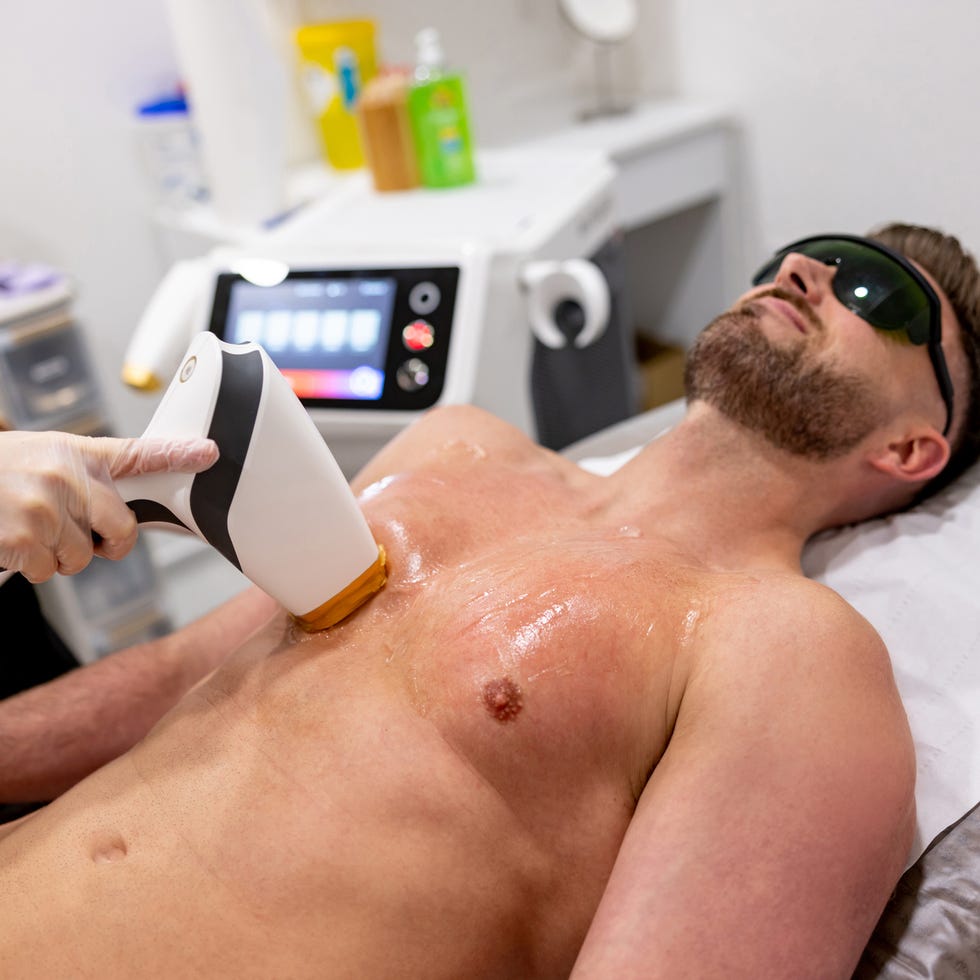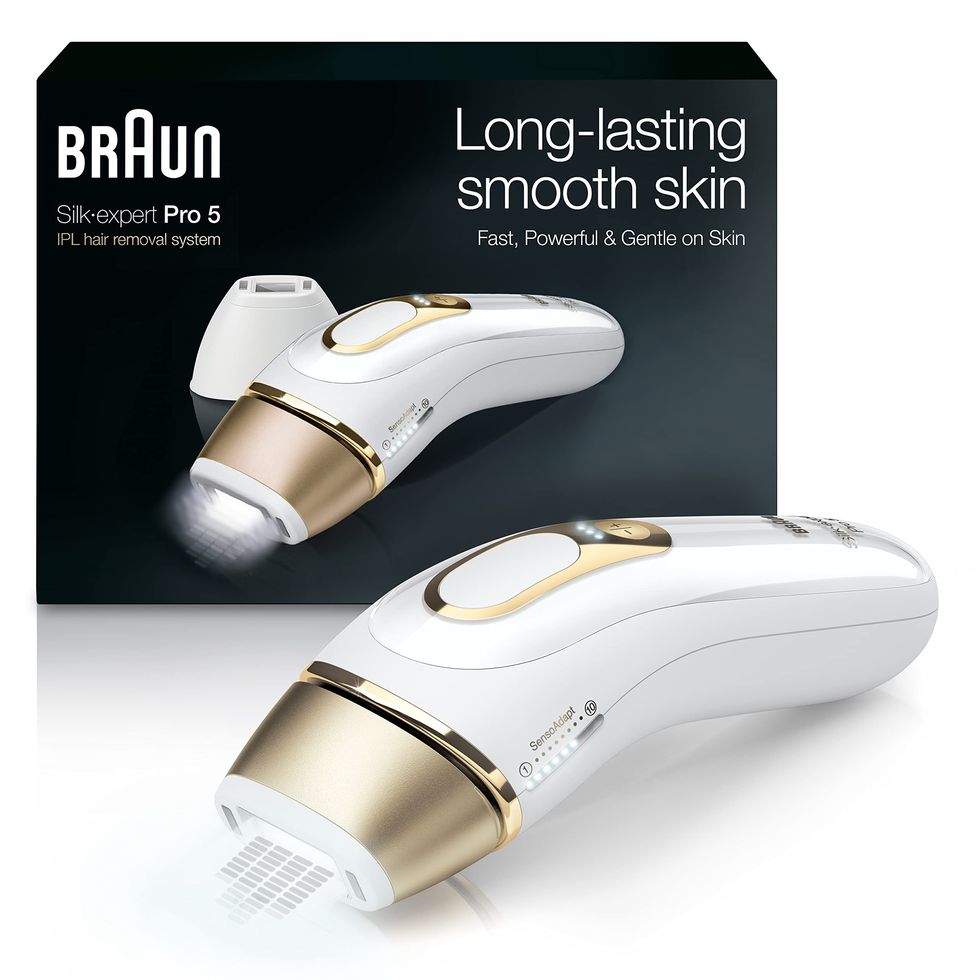
Body hair — some guys love it, some guys loathe it. If you’re feeling a little too fuzzy for comfort, you could shave, you could pull a Steve Carell in The 40-Year-Old Virgin and get waxed or you could pursue a high-tech option — laser hair removal.
According to Mayo Clinic, laser hair removal works when a concentrated beam of light is directed through a laser at an area of the body with unwanted hair. The light is absorbed by the pigment, or melanin, in the hair itself. The beam of light heats up the skin, which damages follicles in the skin so they can either no longer grow hair, or so the growth process is significantly delayed.
Although it’s estimated that 82% of those who get professional laser hair removal are women, “laser hair removal is just as successful in men as it is in women,” says Evan Rieder MD, a board certified dermatologist and psychiatrist in New York City. In some cases, the process is more effective in men. “Some guys do better with laser hair removal on the face than women do, as the higher density of oil glands in men allows for better healing,” Dr. Reider adds. Men also seek laser hair removal for their backs, chests, legs (especially if they’re involved in certain sports, such as swimming) and private areas.
If you’re a guy who’s interested in laser hair removal, it’s important to get evaluated by a cosmetic dermatologist who is experienced in the procedure. “Beauty clinics” that offer laser hair removal may be plentiful online, but that doesn’t mean they’re safe — an untrained technician can hurt someone severely.
Here are other key facts a guy needs to know before having laser hair removal to help you get the best results.
1. You really have to commit.
Laser hair removal is pretty much permanent after a couple of sessions, which can be as short as 10 minutes, depending on the body part. “After three or four treatments, about 90% of the hair in the area of your body will be reduced,” says Jill S. Waibel, MD, medical director of Miami Dermatology and Laser Institute in Miami, Florida, and subsection chief of dermatology at Baptist Hospital. “Many men choose to have laser hair removal on their backs, specifically.”
There can be situations in which more treatments are necessary, however. If you have ingrown hair, additional treatment time will probably be required. The texture of a man’s hair can also make a difference. “Due to testosterone, men tend to have thicker and denser hairs than women do, and may need more treatments,” says Emily L. Guo, MD, FAAD, a board-certified dermatologist at Dermatology & Laser Surgery Center in Houston. “There may also be a shorter interval in which touch up or maintenance treatment is needed after an initial treatment series. Typical follow-up treatments are scheduled anywhere between 4–6 weeks later, to allow time for hairs to regrow in their cycle.”
2. Laser hair removal can be pricey.
According to the American Society of Plastic Surgeons, the cost of laser hair removal treatment vary widely, depending on the area of the country and how many sessions are needed. Patients can also be charged for additional procedure costs, as well as for medications they need related to treatment. All in all, laser hair removal can add up to thousands of dollars, an important consideration when you’re deciding if it’s right for you.
3. Skin tone and hair color should be considered.
“In general, when the hair is thicker, the hair is dark and there is contrast between the skin and hair color — such as light skin and dark hair — the results are more predictable,” says Dr. Reider. “Men with darker skin tones can still get laser hair removal, although the side effect risk profile is higher. People with extremely fine hair or light or white hair should not have the procedure done, as the laser is unlikely to be effective. The laser targets pigment, so it’s not effective for white hair — and if the skin is heat-sensitive or tanned from the sun, it increases the risk for a laser burn.”
It’s important to ask the doctor what kind of equipment they’ll be using. “Darker skin tones require a longer wavelength laser,” says Dr. Waibel. “This is key, because it’s necessary to cool the upper layer of skin to avoid hyperpigmentation.”
4. There might be side effects.
Minor side effects lasting about 1–3 days can include swelling, red skin and discomfort, says the American Academy of Dermatology. Rarely, you could experience skin blisters, or a cold sore outbreak if you have herpes simplex. Infections and scarring can also occur if laser hair removal is not performed correctly.
5. Doing the right prep is crucial.
“Men should be aware that it’s important to shave before laser hair removal appointments so that the laser energy can reach the bulb of the hair underneath the skin, rather than just singeing the hairs on its surface,” says Dr. Guo. “Don’t wax or pluck any hairs beforehand, though, as that removes the target for the laser, and will reduce the efficacy of the treatment.”
It’s important to be careful when spending time in the sun, both before and after a treatment. “Using quality sunscreen is important as well, to reduce the risk of unwanted side effects,” Dr. Guo continues.
Also, showering isn’t advised before the appointment. Once body hair has gotten wet, its growing pattern may be harder to see. The dermatologist will want to examine how hairs lie on the body to be able to administer the treatment correctly.
6. The pain is very manageable.
Comfort is a priority when you go to a qualified practitioner. “We use topical lidocaine as a numbing agent,” explains Dr. Waibel. “Don’t use any lidocaine yourself before you come, though — for safety’s sake, your dermatologist must numb you.” The amount of lidocaine used depends on how dense the hair is, plus where on the body it will be removed. It’s important to discuss pain tolerance with the doctor, too, so they can gauge if more numbing will be needed.
Laser hair removal should not feel that bad, though. “The laser typically feels like a rubber band snapping sensation,” says Dr. Guo. The laser will also feel a little warm. Many doctors who administer the treatment are also patients, so they understand what you’ll experience. “Having treated many people and experienced laser hair removal myself, I can tell you that the procedure is quite tolerable,” says Dr. Reider.
7. The actual process is straightforward.
Before a treatment starts, “the hair is shaved down so that only tiny stubble remains,” says Dr. Reider. “The patient puts on protective goggles, and then pulses of high energy laser light are sequentially applied to the areas with hair.”
The equipment sounds like a vacuum. “We work on one body part at a time, and we take care to make sure patients don’t breathe in any of the laser fumes during a procedure,” says Dr. Waibel. “This is because protein in burning hair is carcinogenic.”
8. Some medical conditions can be helped by laser hair removal.
“Laser hair removal is a very reliable and excellent treatment for medical issues like folliculitis, which is the inflammation of hair follicles, or pseudofolliculitis barbae, where hairs repeatedly grow inward and causes inflammation, hyperpigmentation and scarring,” says Dr. Reider.
If you’re experiencing any unusual hair growth symptoms before the treatment, though, you should see your regular physician immediately — and certainly before any laser hair removal. Sudden hair growth can be due to a range of medical problems, from hormonal disorders to tumors to medication reactions, so the cause should be diagnosed and treated first and foremost.
9. Laser hair removal can be done at home.
Yes, there are at-home devices available, but note: They have less power than those used by a dermatologist, and because of this more frequent use is needed.
Also, it’s recommended that you consult with your doctor to get the okay before trying laser hair removal on your own–and of course, it’s in your interest to use a safe product.
These four options below were all cleared by the FDA and vetted by The Good Housekeeping Institute’s beauty analysts.

Contributing Writer
Lisa is an internationally established health writer whose credits include Good Housekeeping, Prevention, Oprah Daily, Woman’s Day, Elle, Cosmopolitan, Glamour, Parade, Health, Self, Family Circle and Seventeen. She is the author of eight best-selling books, including The Essentials of Theater.
Beauty, Health & Sustainability Lab Executive Director
Birnur (she/her) has led the Beauty, Health and Sustainability Lab at the Good Housekeeping Institute since 2007. In addition to overseeing product testing and GH Seal applications, she conducts the brand’s annual Beauty Awards selection process and is an active leader in GH’s green initiatives, including the Sustainable Innovation Awards and Raise the Green Bar Summit. In addition to earning M.Eng. and Ph.D. degrees in chemical engineering, she recently earned a professional certificate in sustainability management from Columbia University.
Xhicboutique.com – Search for this Product & More at Super Prices!
Source link



